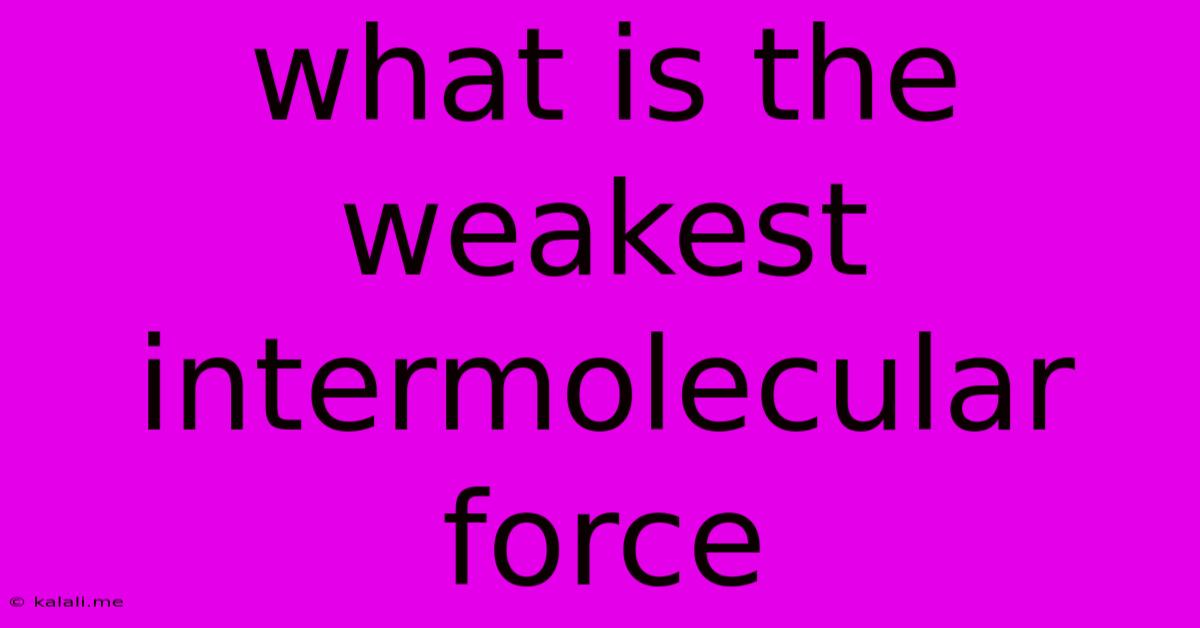What Is The Weakest Intermolecular Force
Kalali
Jun 16, 2025 · 3 min read

Table of Contents
What is the Weakest Intermolecular Force?
Understanding intermolecular forces is crucial for comprehending the properties of matter, from the boiling point of water to the structure of proteins. These forces, unlike intramolecular forces (like covalent bonds within a molecule), are the attractions between molecules. Of these various forces, London Dispersion Forces (LDFs) are universally present and consistently identified as the weakest. This article will delve into the nature of LDFs and explain why they are considered the weakest intermolecular force.
What are London Dispersion Forces?
London Dispersion Forces, also known as instantaneous dipole-induced dipole forces, are the result of temporary, fluctuating dipoles within molecules. Even nonpolar molecules, those with an even distribution of electrons, experience these temporary imbalances. The movement of electrons is constantly shifting; at any given moment, there might be a slightly higher electron density on one side of the molecule, creating a temporary dipole. This temporary dipole then induces a dipole in a neighboring molecule, leading to a weak attractive force.
Think of it like this: imagine a perfectly balanced seesaw. Occasionally, the electrons might bunch up on one side, creating a momentary imbalance – a temporary dipole. This imbalance influences the electrons on a nearby seesaw (molecule), causing a similar, albeit temporary, imbalance. This temporary attraction, though fleeting, is the basis of LDFs.
Why are LDFs the Weakest?
Several factors contribute to the weakness of LDFs:
- Temporary Nature: The dipoles responsible for LDFs are fleeting and constantly changing. This means the attractive force is very short-lived and relatively weak.
- Weak Magnitude: The magnitude of the induced dipole is considerably smaller than the permanent dipoles found in polar molecules. This inherent weakness limits the overall strength of attraction.
- Distance Dependence: LDFs are highly dependent on the distance between molecules. The closer the molecules, the stronger the interaction. However, this force diminishes rapidly with increasing distance.
- Polarizability: The ease with which the electron cloud of an atom or molecule can be distorted to form a temporary dipole is called polarizability. Larger molecules with more electrons are generally more polarizable and have stronger LDFs than smaller molecules with fewer electrons. However, even in larger molecules, these forces remain relatively weak compared to other intermolecular forces.
Other Intermolecular Forces: A Comparison
To fully understand why LDFs are the weakest, it's helpful to compare them with other types of intermolecular forces:
- Dipole-Dipole Forces: These occur between polar molecules possessing permanent dipoles. The positive end of one molecule attracts the negative end of another, resulting in a stronger attraction than LDFs.
- Hydrogen Bonding: This is a special type of dipole-dipole interaction involving hydrogen bonded to a highly electronegative atom (like oxygen, nitrogen, or fluorine). Hydrogen bonds are significantly stronger than both LDFs and typical dipole-dipole forces.
- Ion-Dipole Forces: These interactions occur between ions and polar molecules, and are significantly stronger than LDFs due to the presence of a full charge on the ion.
Conclusion
While London Dispersion Forces are present in all molecules, their inherent temporary nature, weak magnitude, and distance dependence make them the weakest intermolecular force. While individually weak, the cumulative effect of numerous LDFs can be significant, especially in large molecules. Understanding the relative strengths of different intermolecular forces is crucial for predicting and explaining a wide range of physical properties of substances.
Latest Posts
Latest Posts
-
How To Create Clickable Image In Html
Jun 16, 2025
-
What Are The Factors Of 121
Jun 16, 2025
-
What Is A Theme Of The Passage
Jun 16, 2025
-
A Company That Provides Access To The Internet
Jun 16, 2025
-
Which Word Is Closest In Meaning To The Underlined Word
Jun 16, 2025
Related Post
Thank you for visiting our website which covers about What Is The Weakest Intermolecular Force . We hope the information provided has been useful to you. Feel free to contact us if you have any questions or need further assistance. See you next time and don't miss to bookmark.